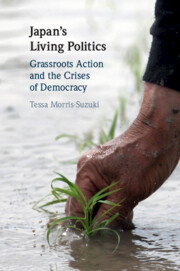Book contents
- Japan’s Living Politics
- Japan’s Living Politics
- Copyright page
- Contents
- Maps
- Figures
- Acknowledgements
- Maps
- 1 Japan and the Crisis of Democracy
- 2 Living Politics
- 3 The White Birch and the Earth
- 4 Rethinking the Village
- 5 Peasant Art, Free Drawing and the Free University
- 6 The Body Politic
- 7 Seeds of Democracy
- 8 Development from Within
- 9 Disaster and Aftermath
- 10 Conclusions and Beginnings
- Bibliography
- Index
5 - Peasant Art, Free Drawing and the Free University
Published online by Cambridge University Press: 16 April 2020
- Japan’s Living Politics
- Japan’s Living Politics
- Copyright page
- Contents
- Maps
- Figures
- Acknowledgements
- Maps
- 1 Japan and the Crisis of Democracy
- 2 Living Politics
- 3 The White Birch and the Earth
- 4 Rethinking the Village
- 5 Peasant Art, Free Drawing and the Free University
- 6 The Body Politic
- 7 Seeds of Democracy
- 8 Development from Within
- 9 Disaster and Aftermath
- 10 Conclusions and Beginnings
- Bibliography
- Index
Summary
In this chapter I trace the history of a network of movements originating in the small mountain village of Kangawa, near Ueda City, in the 1920s and 1930s. The first of these was the Peasant Art Movement, a project developed by artist Yamamoto Kanae and others from 1919 onward to promote local prosperity by encouraging handicraft production. This was closely linked to the Free Drawing Movement, in which Yamamoto also played a central role: a project to promote individuality and creativity through children’s art education. A third significant movement originating in Kangawa was the Free University, in which a central figure was philosopher Tsuchida Kyōson. Free Universities, created in Ueda and later in other parts of Japan, aimed to provide adult education to farmers and others, enabling them to acquire the intellectual autonomy needed to be active citizens in a democratizing society. The chapter examines the connection between these activities and the ambiguous role of Youth Groups (Seinendan) in rural Japan during the 1920s and 1930s. It also discusses the suppression of the Free University movement in the context of rising militarism, and the legacies of the movement for postwar Japan.
- Type
- Chapter
- Information
- Japan's Living PoliticsGrassroots Action and the Crises of Democracy, pp. 90 - 116Publisher: Cambridge University PressPrint publication year: 2020

